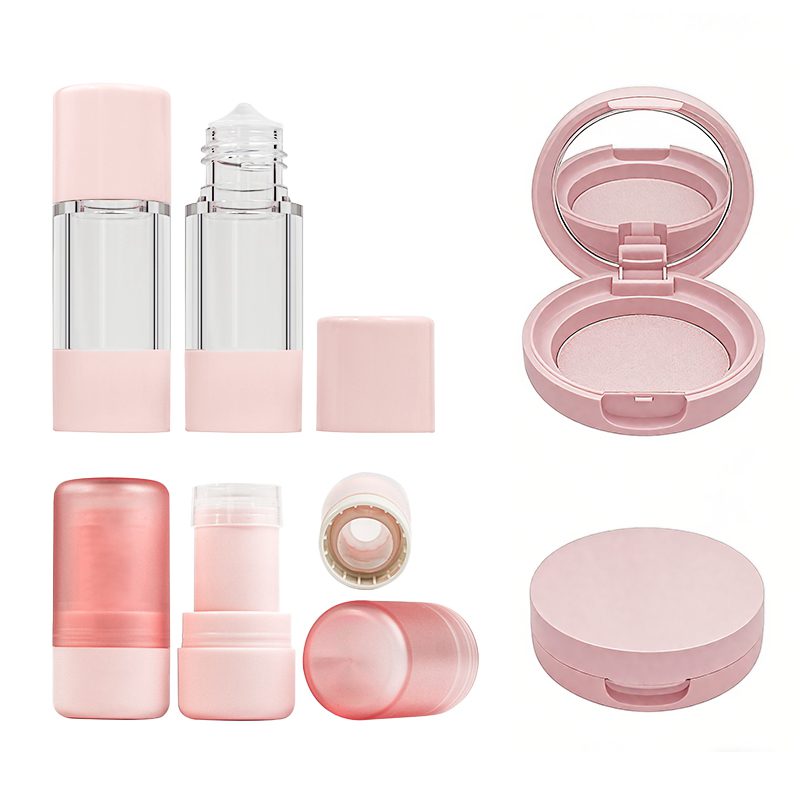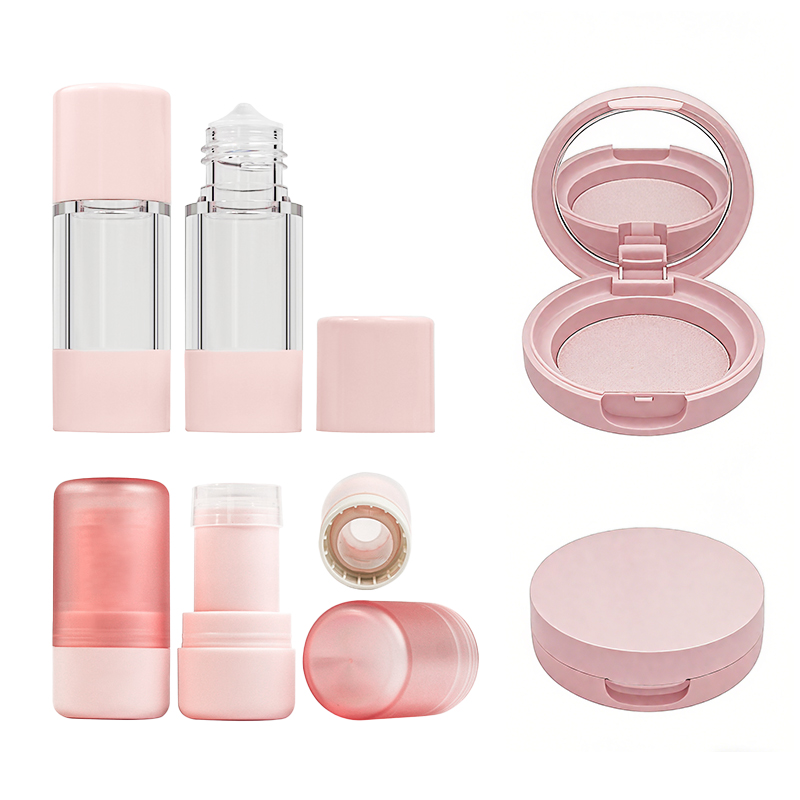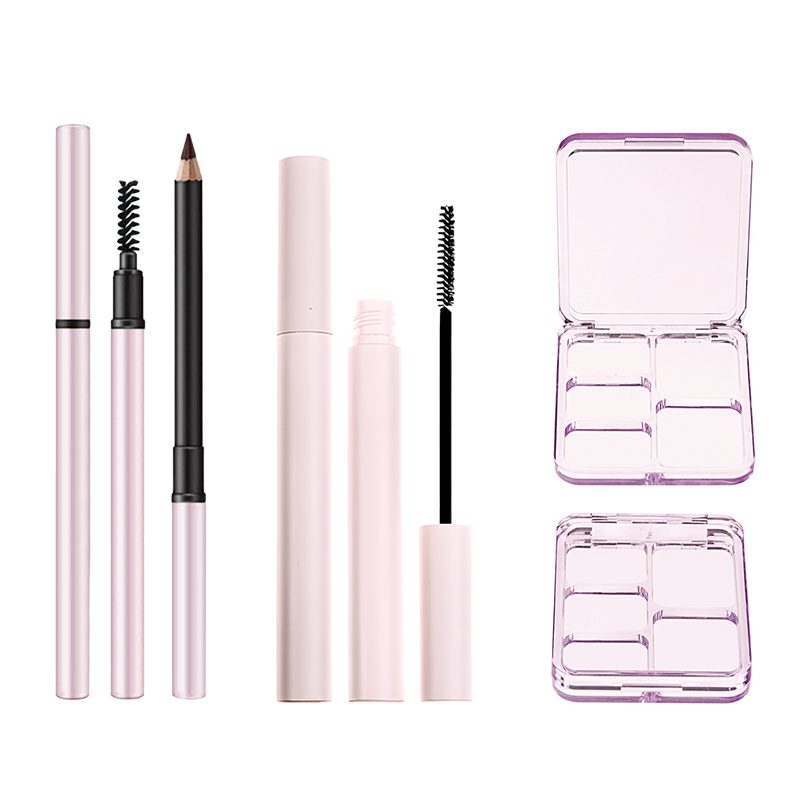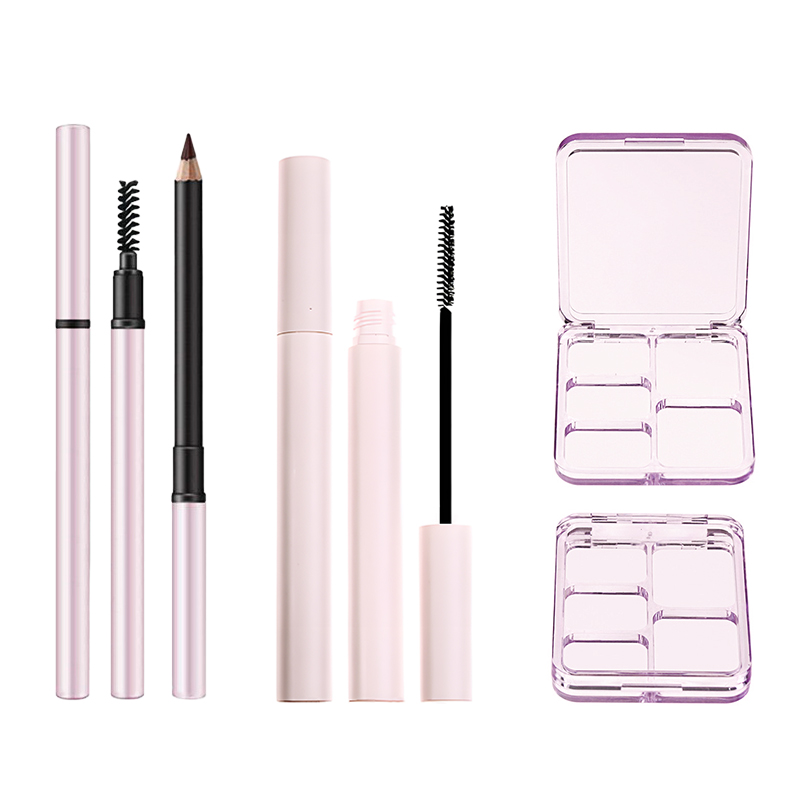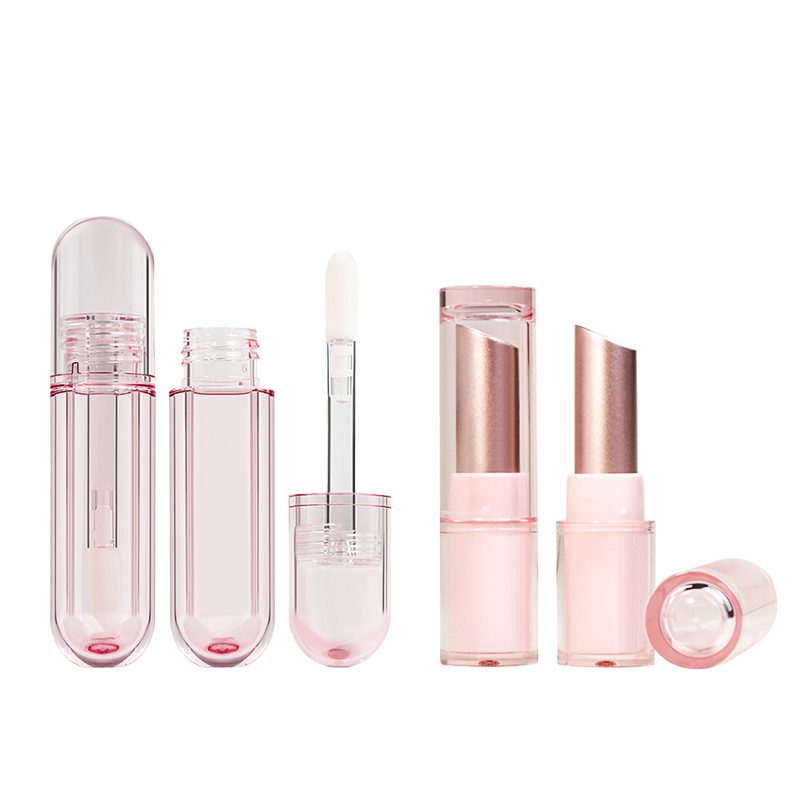Quick Tips for Choosing Packaging for Your Cosmetics
You ever pick up a moisturizer just because the bottle looked like it belonged in a minimalist art museum? Yeah—same. In the beauty biz, packaging cosmetics isn’t just about squirting cream into a jar. It’s theater. It’s storytelling. One wrong cap, and your product screams “cheap” before customers even take a whiff. And don’t get me started on wasteful materials that make eco-conscious shoppers side-eye your entire brand.
Choosing the right look and feel for your product line is like casting lead roles in a movie—you want charisma, function, and mass appeal without blowing your budget on glittery nonsense that flakes off anyway. Packaging is where practicality meets pizzazz; skip it, and you’re invisible on shelves faster than last season’s contour sticks.
Key Points in the Art & Ethics of Packaging Cosmetics
➔ Material Matters: PET plastic, bamboo, and PCR content strike a balance between durability and sustainability.
➔ Design for the Eye: Hot stamping, metallization finishes, and custom PMS colors elevate shelf appeal with artistic flair.
➔ Functional Closures: Pump dispensers, screw caps, and snap closures offer convenient usability without sacrificing style.
➔ Sustainable Moves: Embrace refillable systems and mono-material designs to enhance recyclability and reduce waste.
➔ Budget Beauty Hacks: Affordable solutions like 15 ml PET tester tubes or matte black aluminum shells prove you don’t need big bucks to stay on-brand.
3 Key Factors for Cosmetic Packaging Success
Nail the trifecta of success when it comes to packaging your beauty products—materials, looks, and functionality matter more than ever.
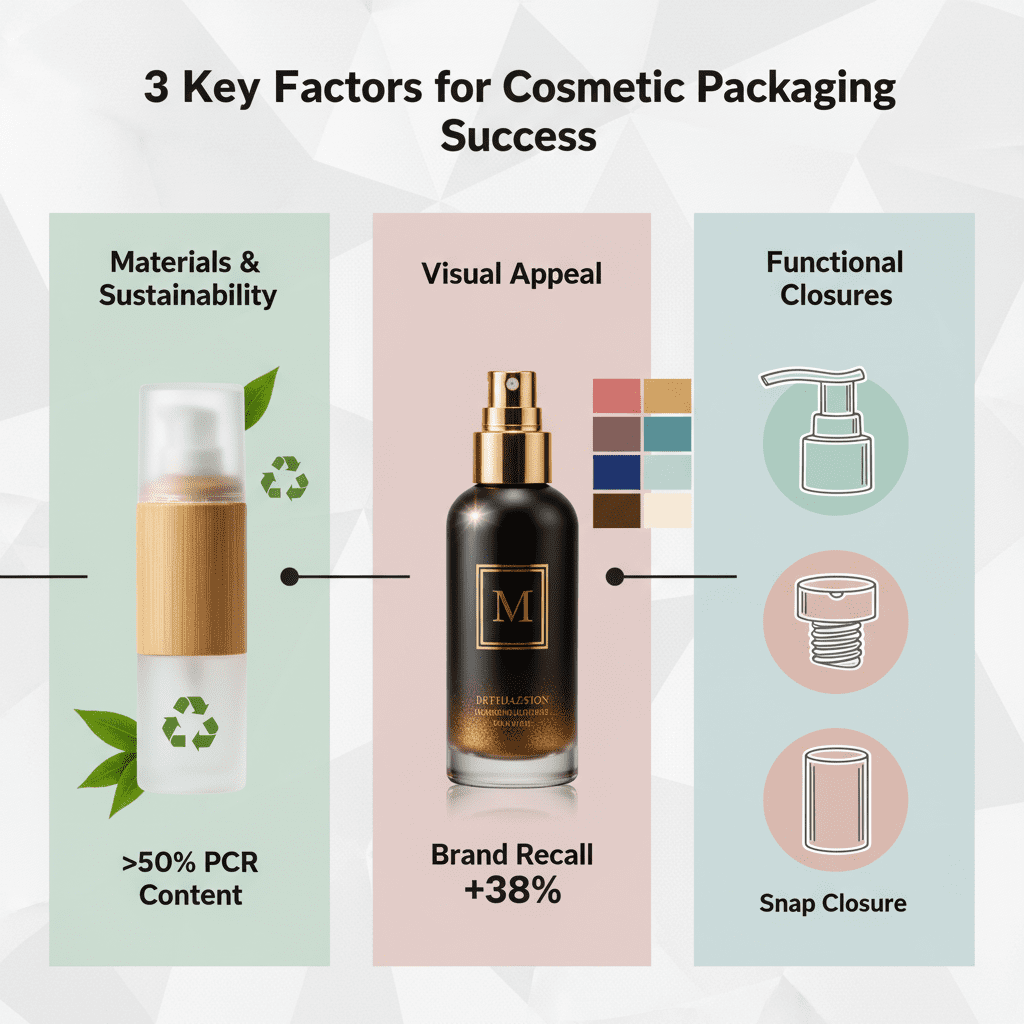
Material & Sustainability: PET Plastic, Bamboo Packaging & PCR Content
When it comes to choosing materials for cosmetic packaging, brands are getting smarter—and greener:
- PET Plastic is lightweight, durable, and fully recyclable—a no-brainer for mass-market lines.
- Bamboo Packaging adds a natural vibe and cuts down on plastic use without sacrificing style.
- PCR Content (Post-Consumer Recycled) lets you reuse what’s already out there—great for eco-minded customers.
More consumers now expect brands to show up sustainably.
Visual Appeal Through Hot Stamping, Metallization Finish & Custom PMS Colors
Design isn’t just about looking good—it’s about being remembered. Here’s how to make your product pop off the shelf:
• Add shimmer with a metallization finish—chrome-like shine screams premium.
• Use hot stamping to emboss logos or accents with metallic foil; it adds texture and class.
• Pick custom PMS colors that match your brand identity exactly—no guesswork involved.
In fact, according to Mintel’s Q1 Beauty Packaging Insights Report (2024), “color consistency across platforms improves brand recall by up to 38%.” It’s not just pretty—it’s strategic branding baked into your bottle.
Functional Closures Like Pump Dispensers, Screw Caps & Snap Closures
Getting product out smoothly? That matters big time in everyday use.
Step 1: Choose a closure that fits usage habits. For liquids or serums? Go with precise-control pump dispensers.
Step 2: Need something secure but simple? Classic screw caps offer reliability while keeping things tight and tidy during travel.
Step 3: For quick access products like creams or gels? Snappy and satisfying—that’s where snap closures shine.
It sounds small until you realize how much user experience hinges on these little parts. No one likes a leaky lid or messy squeeze!
7 Simple Steps to Master Sustainable Cosmetic Packaging
Sustainable packaging in beauty isn’t just a trend—it’s the new baseline. Let’s break it down into seven easy-to-grasp moves.
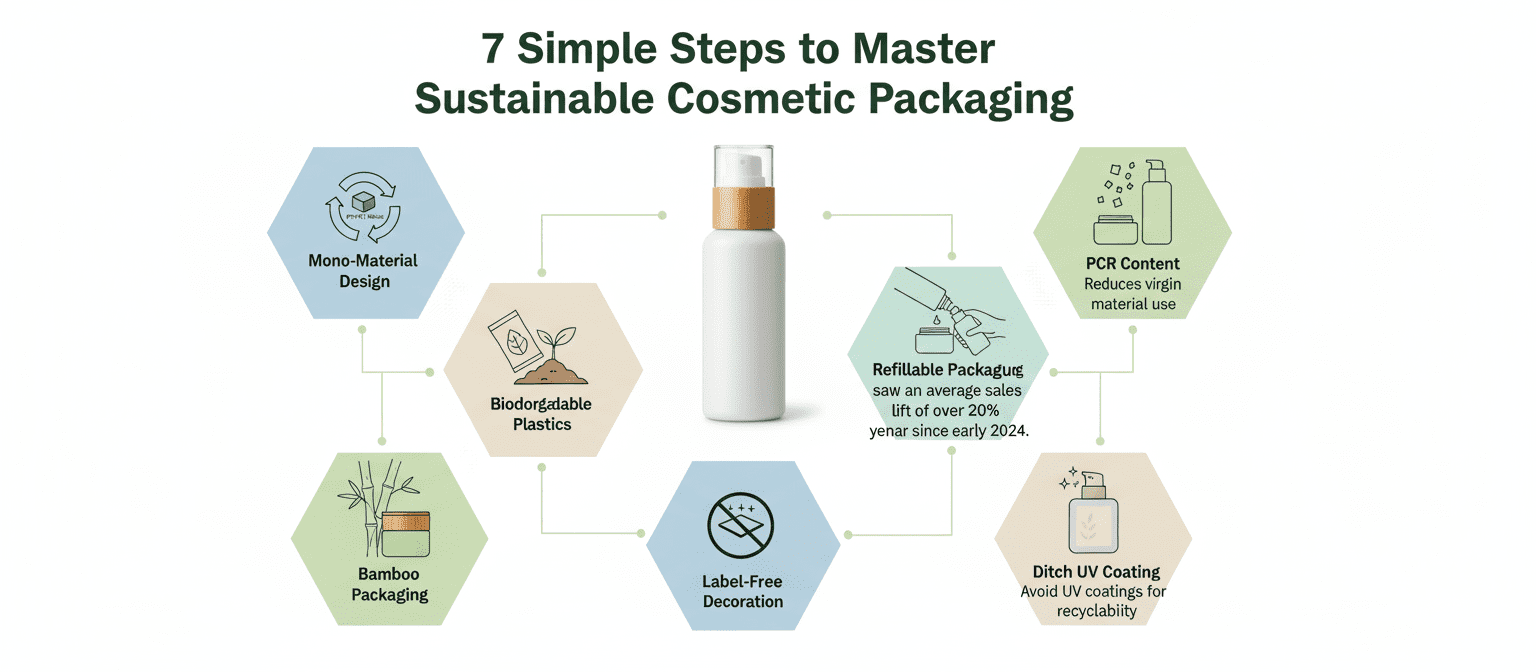
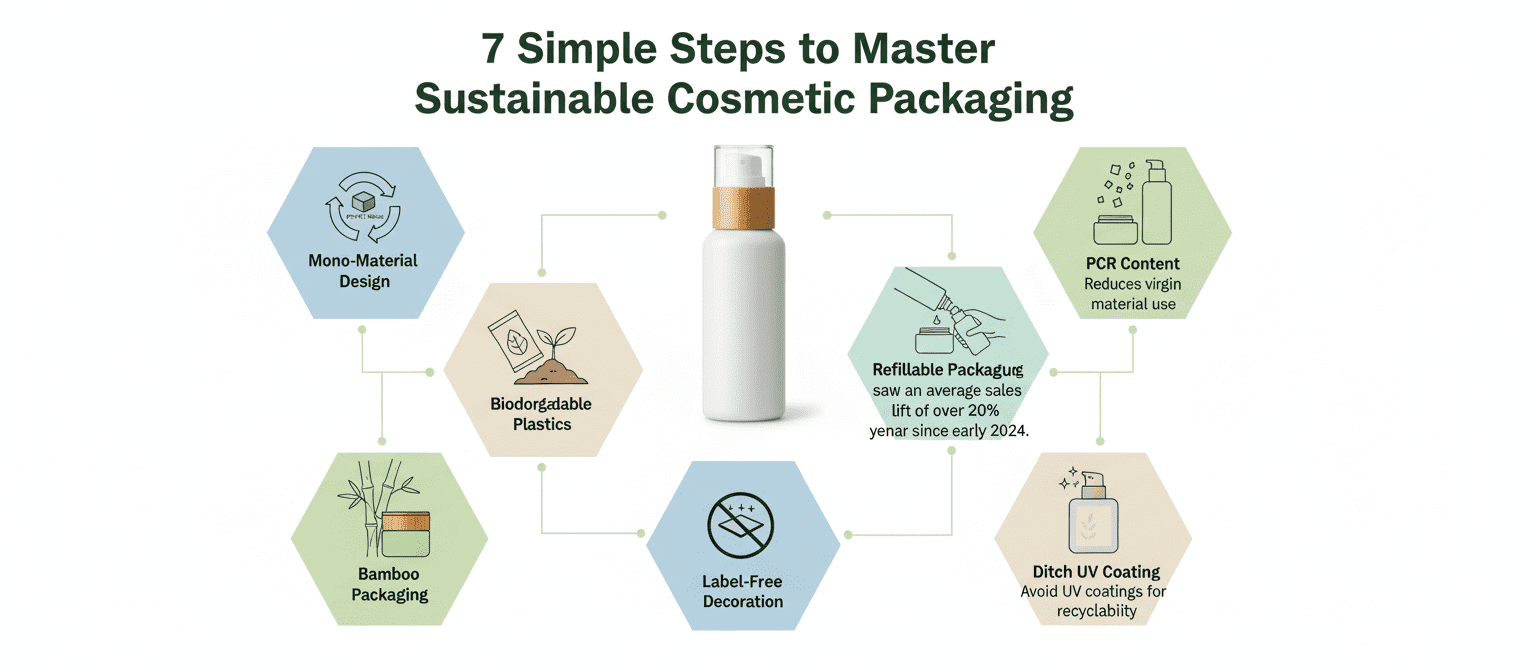
How Mono-Material Design Enhances Circularity
- Mono-material design makes sorting a breeze at recycling plants. No glue, no mixed layers—just one clean material.
- This simplicity improves circularity, meaning materials can re-enter production loops with less processing.
- For example, using only polypropylene across lids and tubes reduces contamination risks.
- Brands focusing on this are cutting costs while boosting their green cred.
When you keep your packaging uniform, you’re not just helping recyclers—you’re setting up your product for long-term sustainability wins.
PCR Content: Giving New Life to PET Plastic
- PCR stands for post-consumer recycled content—basically, it’s plastic that’s been used once and given a second shot.
Grouped Benefits:
• Reduces virgin material use
• Cuts down carbon emissions from plastic production
• Keeps waste out of landfills
Using PCR in your cosmetic containers doesn’t mean sacrificing aesthetics either. Today’s tech lets you mold high-quality finishes from reused PET plastic, keeping both style and conscience intact.
The Emergence of Biodegradable Plastics in Cosmetics
Some materials don’t need a recycling bin—they vanish naturally over time. That’s the promise behind biodegradable plastics.
These new-age polymers break down under composting conditions, making them ideal for single-use items like sample sachets or disposable applicators. They help reduce microplastic pollution and align with eco-conscious branding strategies. When brands use compostable alternatives, they’re not just cleaning up their act—they’re literally disappearing into the soil.
Refillable Packaging Boosts Both Sales and Sustainability
Grouped Insight:
• Encourages customer loyalty through repeat purchases
• Slashes waste by eliminating constant repackaging
• Lowers long-term production costs
A recent NielsenIQ study found that refillable beauty products saw an average sales lift of over 20% year-on-year since early 2024. That’s not just good news for the planet—it’s great business too.
By offering sleek refill pods or twist-off cartridges, brands tap into both eco values and consumer convenience—all while giving their packaging a second life.
Bamboo Packaging for Modern Sustainable Appeal
- Bamboo grows fast—like really fast—and doesn’t need replanting after harvest.
- It brings a warm, natural touch that screams premium without screaming price tag.
- As a renewable resource, it checks every box on the green list.
That makes it perfect for caps, compacts, jars—anything where texture matters as much as function. Plus, using bamboo packaging signals serious commitment to earth-first thinking without compromising visual appeal.
Embrace Minimalism With Label-Free Decoration
Clear bottles etched with branding? Yes please. Skip the sticky labels altogether by going label-free:
Glossy embossing on glass
Laser etching on metal caps
Direct ink printing on smooth surfaces
This minimalist style isn’t just good-looking—it boosts recyclability too. Labels often mess with sorting machines or gum up pulping processes during recycling. So ditching them makes both aesthetic and practical sense when designing sustainable cosmetic containers.
Ditch UV Coating for Easy Recyclability
1) UV coatings might make things shiny—but they also make them hard as heck to recycle.
2) These glossy layers don’t break down easily during material recovery processes.
3) Swapping them out means fewer headaches at sorting facilities—and fewer rejected materials heading straight into landfills.
By avoiding UV-treated finishes on your beauty containers, you’re doing recyclers everywhere a favor—and giving your brand bonus points in sustainability circles too.
Glass vs. Plastic Cosmetic Packaging
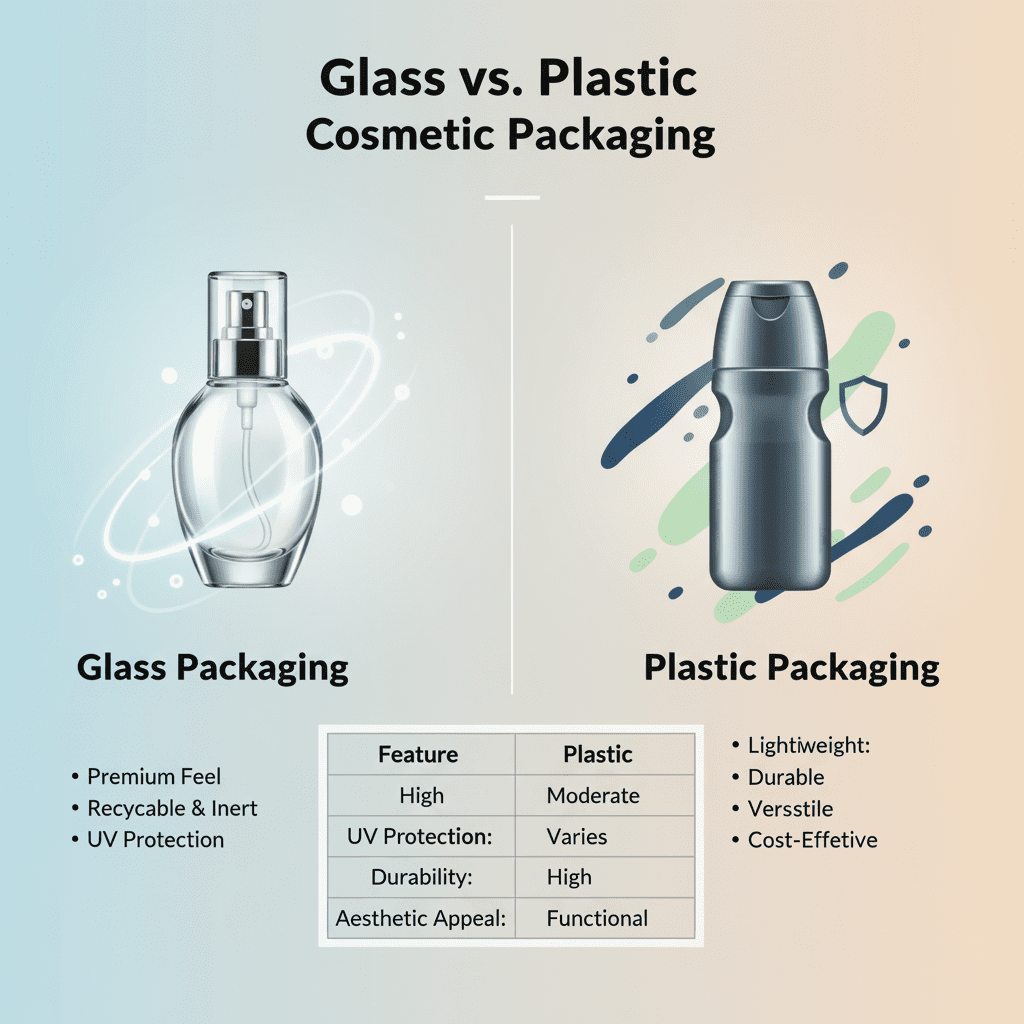
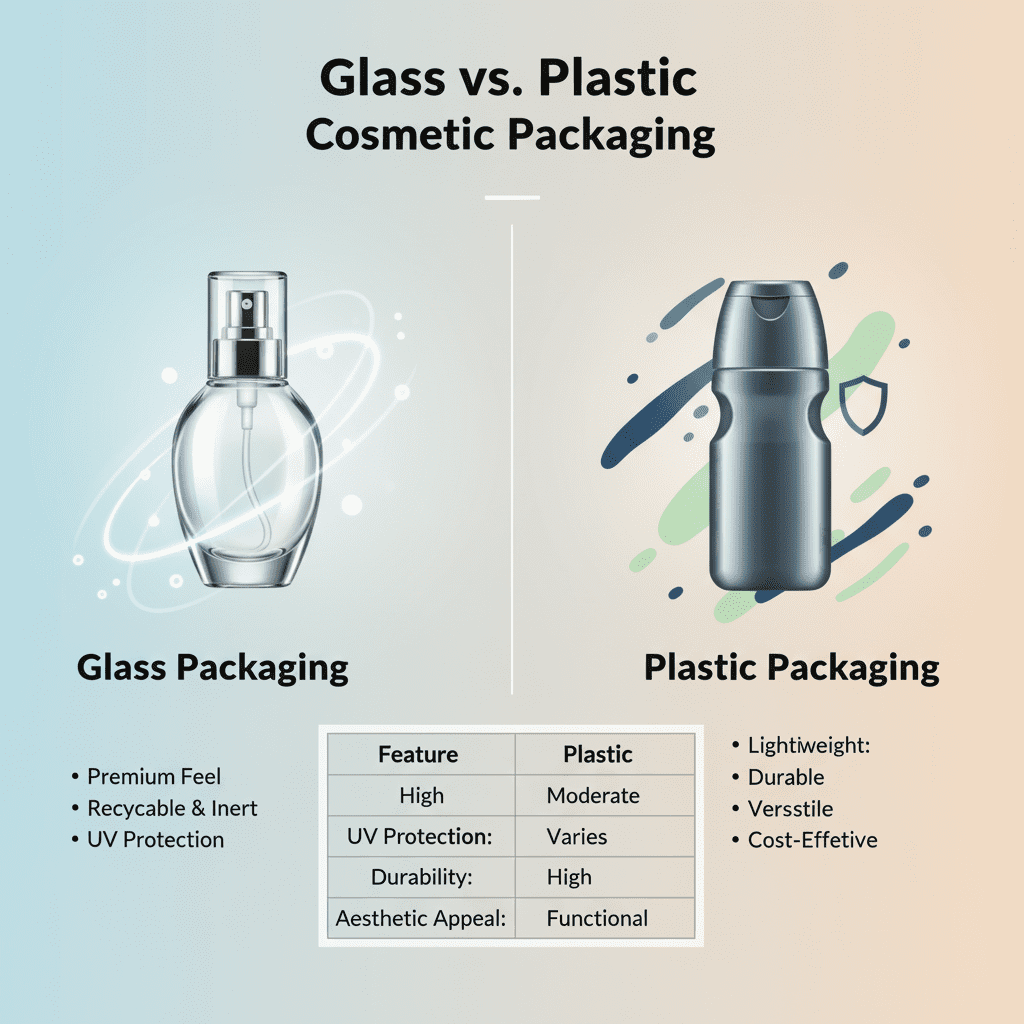
Choosing between glass and plastic for beauty containers isn’t just about looks—it’s about weight, feel, and how your formula behaves inside.
Glass Cosmetic Packaging
• Luxury appeal: The moment you hold it, there’s that unmistakable premium feel—solid, cool to the touch, and undeniably upscale. That’s why high-end brands often go glass.
• Recyclable & inert: It’s not just pretty. Glass is endlessly recyclable, and its inert nature means it won’t react with serums or creams. Your product stays pure longer.
• UV protection & stability: Opaque or amber glass offers built-in UV protection, keeping light-sensitive formulas safe without needing extra packaging layers.
• ⚠️ Fragility factor: Drop it once on tile, and it’s game over. Glass is classy—but also very fragile.
• Weight trade-off: All that chic comes with heft. Glass adds noticeable weight, which might affect shipping costs or portability for on-the-go users.
• Table – Material Comparison Chart:
| Feature | Glass | Plastic | Winner |
|---|---|---|---|
| Recyclability | High | Moderate | Glass |
| UV Protection | Excellent | Varies | Glass |
| Durability | Low | High | Plastic |
| Aesthetic Appeal | Premium | Functional | Depends |
So yeah, if you’re after elegance and don’t mind the bulk—or the occasional shattered bottle—glass has serious perks for packaging your cosmetics cleanly and beautifully.
Plastic Cosmetic Packaging
Plastic’s not just a budget pick—it’s a shapeshifting champ when it comes to form, function, and flexibility for beauty products.
① It’s ridiculously lightweight, making it ideal for travel kits or gym bags where every ounce counts.
② It handles drops like a pro—super durable, so no panic attacks when your lotion hits the tiles.
③ There are endless design options thanks to its insane moldability—think curves, pumps, squeezes—all possible due to its unmatched versatile nature.
④ And yep—it’s wallet-friendly too. You get more packaging bang without busting budgets because plastic is seriously cost-effective.
☆ But wait—there are caveats:
- Some plastics raise eyebrows over long-term sustainability.
- Certain types may have limited recyclability depending on local facilities (recyclability concerns).
- Compatibility with some active ingredients can vary (chemical compatibility)—you’ve gotta match the right plastic type with your formula chemistry.
If you’re dreaming of unique shapes or need something unbreakable but cute? Plastic totally gets the job done while keeping things easy on your arms—and your wallet.
Eyes on Budget? Affordable Packaging Cosmetics Solutions
Looking to cut costs without cutting corners? These budget-friendly picks keep your packaging sharp and your wallet happy.
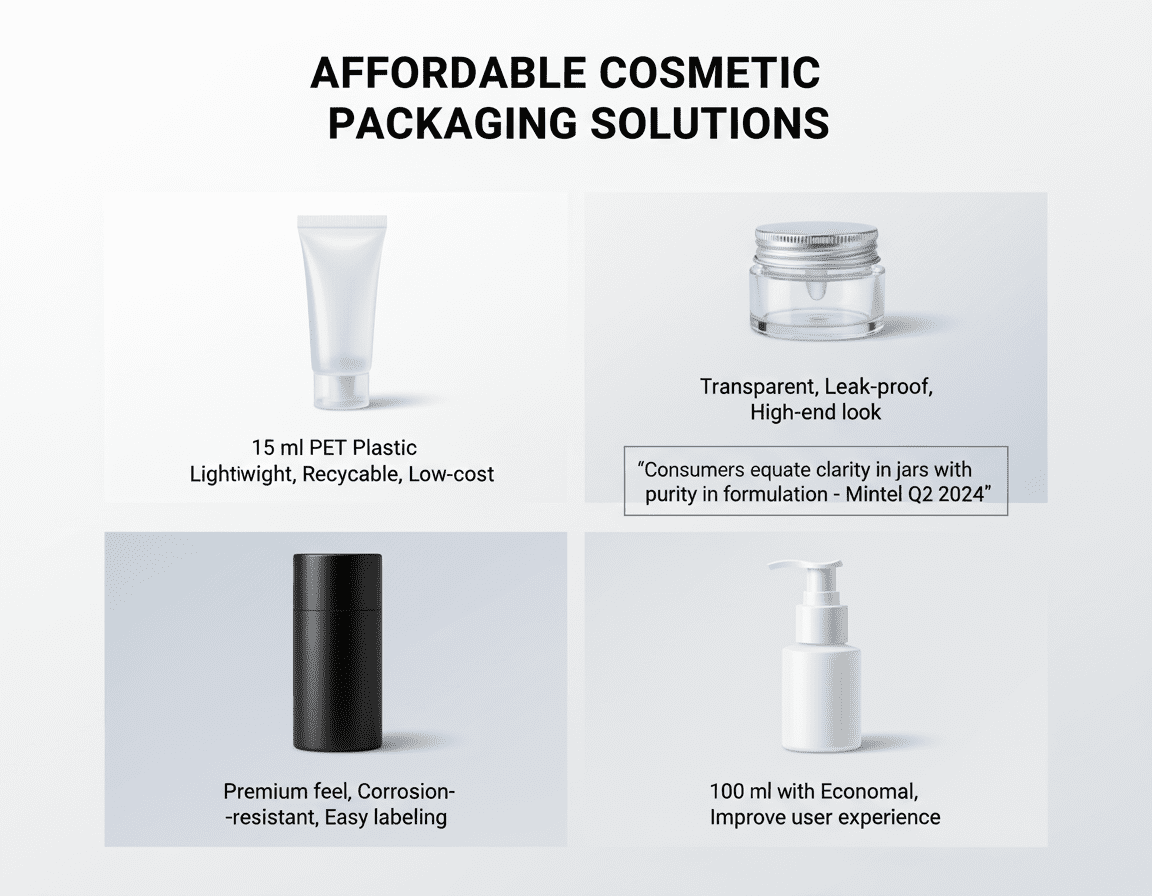
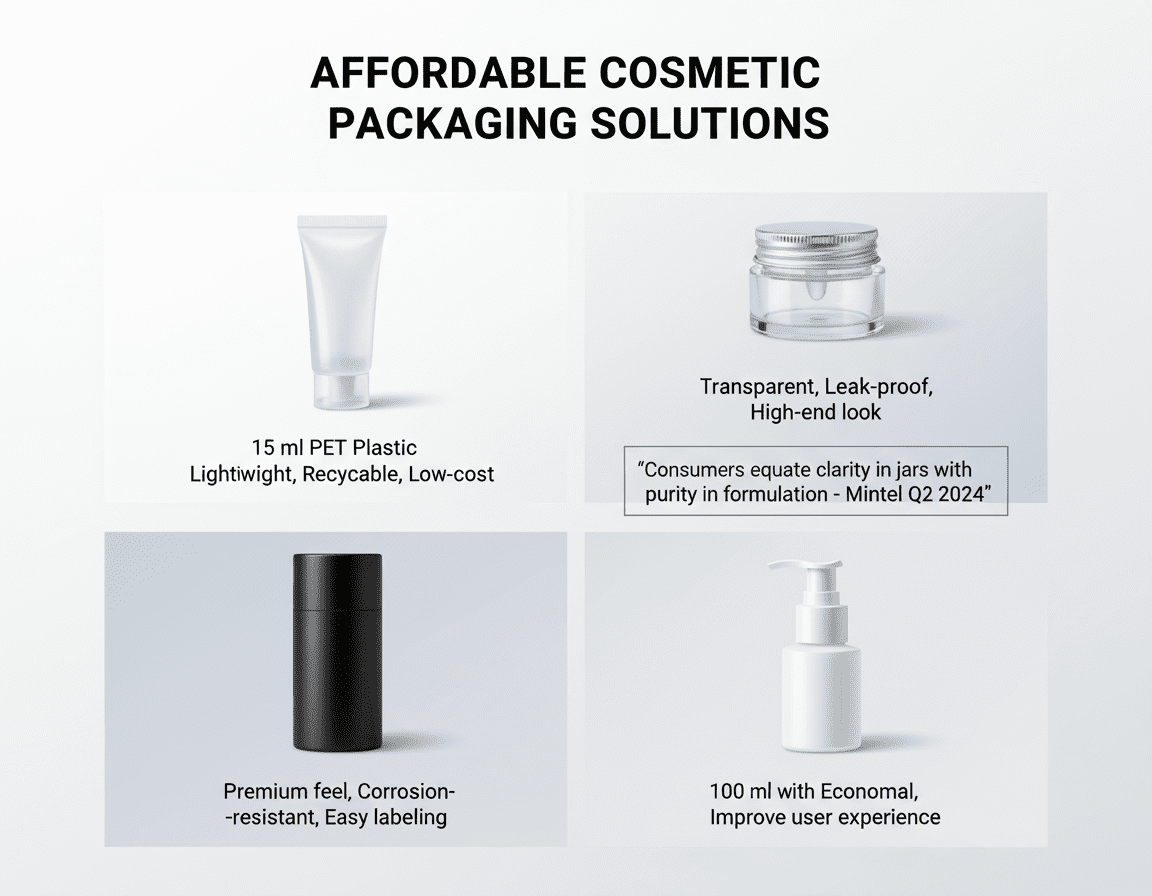
Affordable 15 ml PET Plastic Tubes for Testers
- Lightweight but strong – These PET Plastic tubes are ideal for travel-size or trial versions.
- Low-cost production – Their material and mold flexibility mean lower manufacturing expenses.
- Eco-conscious appeal – Recyclable and durable, they align with clean beauty trends.
You’ll often see indie brands use these compact tubes to test new formulas without blowing their budgets. For small-batch makers, this is the sweet spot between affordability and sleekness—especially when paired with minimalist branding.
Cost-Saving 30 Gram Acrylic Jars With Screw Caps
Grouped by benefit:
💡 Affordability: The base cost of these Acrylic Jars is significantly lower than glass, making them a go-to option for startups.
🧴 Functionality: The tight-sealing Screw Caps prevent leaks, which matters big time in creams and balms.
🎨 Visual Appeal: Their glossy finish mimics high-end packaging at a fraction of the price.
According to Mintel’s Q2 2024 Beauty Packaging Report, “consumers equate clarity in jars with purity in formulation”—so transparent acrylic isn’t just cheap; it’s strategic. Brands like Topfeel have capitalized on this dual perception of value and visual quality.
Matte Black Aluminium Shells With Label Application
Think slick design meets budget control. These Matte Black Aluminium Shells aren’t just about looks—they’re also super practical.
Short segment breakdown:
– They’re lightweight but feel premium in hand.
– Easy to apply custom labels = fast turnaround time.
– Resistant to corrosion = longer shelf life even in humid climates.
When you want something that screams boutique without the boutique price tag, these containers deliver style that doesn’t stress your margins.
Economical Pump Dispensers for 100 ml Bottles
Step-by-step production logic:
- Start with a standard-size bottle—100 ml is perfect for lotions or serums.
- Add an airless or spring-loaded pump—both options reduce waste.
- Choose a universal thread neck—this cuts compatibility issues during assembly.
- Final step: brand it simply but clearly using shrink sleeves or direct print.
These kinds of pumps are popular across mid-tier skincare lines because they balance function with frugality. And since most formulas dispense better through pumps than squeezes or pours, it’s a win-win—you save money while improving user experience across your line of liquid-based products.
FAQs
Sustainability isn’t just a buzzword—it’s reshaping how beauty brands connect with conscious consumers. The right materials can speak volumes:
- PET plastic made with post-consumer recycled (PCR) content reduces waste and keeps things recyclable.
- Bamboo is more than just beautiful—it’s fast-growing, biodegradable, and gives products a natural soul.
- Some newer biodegradable plastics break down naturally without leaving behind harmful traces.
Each of these choices sends a message: your brand cares not only about looking good but doing good too.
Shelf appeal isn’t luck—it’s design that flirts from across the aisle. A flash of metallic foil or an unexpected matte finish can turn casual glances into second looks. Custom PMS colors create consistency across campaigns and product lines, making your brand instantly recognizable even at a distance. When done well, decoration becomes identity—and identity sells.
Absolutely—and they don’t have to feel cheap:
- 15 ml PET tubes work great for testers or travel-size items while keeping costs low.
- Acrylic jars around 30 grams hit the sweet spot between sturdy and stylish.
- Matte black aluminum shells offer sophistication at scale—especially when paired with custom labels.
Smart sourcing means you don’t sacrifice aesthetics for savings.
It all comes down to control and experience. Pump dispensers give users clean application without mess—a must for daily-use foundations. Dropper caps bring precision to serums where every drop counts. Screw caps may seem basic, but their reliability makes them ideal when airtight sealing is essential during shipping or storage.
Think less about trends here—more about function meeting feeling in every use.
Yes—but it has to be done thoughtfully. Refillable systems aren’t just eco-friendly; they invite customers back again and again by turning routine purchases into rituals of care—for themselves and the planet. It’s not just another jar—it’s theirs now, refilled by choice rather than habit. That emotional connection drives repeat business like nothing else can.


